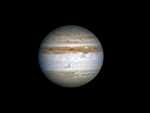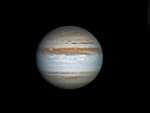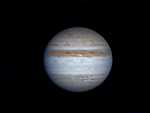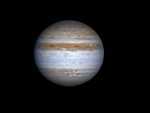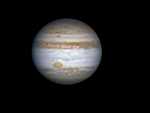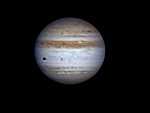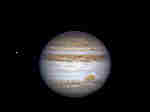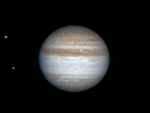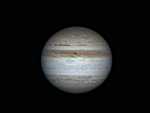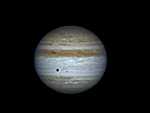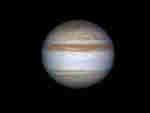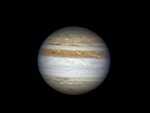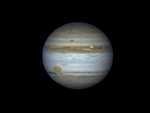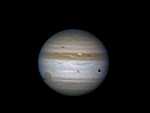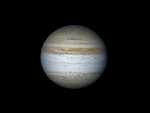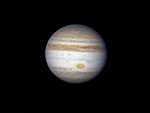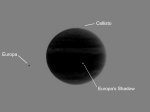
2010 Jupiter Images
Web Camera Images
Capture Notes: Philips SPC900 NC web camera, unless otherwise indicated, with an IR blocking filter. 8 inch Meade LXD55 SCT and 3X barlow.
K3CCDTools version 1 was used to record the videos unless otherwise indicated. Camera settings recorded with WcCrtl unless otherwise indicated.
Processing Notes: Final processing has been done using Registax versions 3 or 4 for stacking, Astra Image for removing diagonal bands through Fast Fourier Transform edits and for applying deconvolution.
PhotoShop CS2 or Paint Shop Pro 9 have been used for adjusting levels, curves and color, while Neat Image is used for digital noise removal.
January 04, 2011 at 0:45 UT.
The region of South Equatorial Belt where the outbreak began is visible in this image. Camera settings: 1/33 second exposure, brightness: 50%, gamma 0%, saturation 100%, gain: 41%. 250 frames stacked. Seeing was poor (~2 out of 5). Angular diameter 38.3".
December 26, 2010 at 0:45 UT.
The Great Red Spot is visible in this image. Notice that the South Equatorial Belt is beginning to take shape again. Camera settings: 1/33 second exposure, brightness: 50%, gamma 0%, saturation 100%, gain: 41%. 350 frames stacked. Seeing was average (~3 out of 5). Angular diameter 39.4".
December 09, 2010 at 0:58 UT.
Camera settings: 1/33 second exposure, brightness: 50%, gamma 0%, saturation 100%, gain: 52%. 350 frames stacked. Seeing was good (~4 out of 5). Angular diameter 41.7".
December 07, 2010 at 1:35 UT.
Red Spot Jr. is visible at the lower left. Camera settings: 1/33 second exposure, brightness: 50%, gamma 0%, saturation 100%, gain: 40%. 400 frames stacked. Seeing was good (~4 out of 5). Angular diameter 41.9".
December 01, 2010 at 2:37 UT.
The South Equatorial Belt break out is visible in this image. Io is visible to the left of Jupiter. Camera settings: 1/33 second exposure, brightness: 50%, gamma 0%, saturation 100%, gain: 41%. 175 frames stacked. Seeing was poor (~2 out of 5). Angular diameter 42.8".
November 28, 2010 at 1:40 UT.
The Great Red Spot and Red Spot Jr. are visible. Camera settings: 1/33 second exposure, brightness: 50%, gamma 0%, saturation 100%, gain: 40%. 400 frames stacked. Seeing was average (~3 out of 5). Angular diameter 43.2".
November 14, 2010 at 2:50 UT.
The South Equatorial Belt is beginning to break out as can be seen here. This disturbance was first reported on Nov. 9, 2010. It started as a bright white feature and has begun to spread out. Camera settings: 1/33 second exposure, brightness: 50%, gamma 0%, saturation 100%, gain: 40%. 250 frames stacked. Seeing was poor to average (~2 to 3 out of 5). Angular diameter 45.2".
November 11, 2010 at 2:45 UT.
The Great Red Spot is visible in the lower right. Camera settings: 1/33 second exposure, brightness: 50%, gamma 0%, saturation 100%, gain: 43%. 250 frames stacked. Seeing was poor to average (~2 to 3 out of 5). Angular diameter 45.6".
October 31, 2010 at 2:31 UT.
Three moons are visible in this image. Europe is in transit near the center of Jupiter. Ganymede is at the lower right and Io is at the upper right. Camera settings: 1/33 second exposure, brightness: 50%, gamma 0%, saturation 100%, gain: 37%. 200 frames stacked. Seeing was average (~3 out of 5). Angular diameter 47.0".
October 29, 2010 at 3:04 UT.
Imaging Source DBK 21AF04.AS color camera. Camera settings: 1/30 second exposure, brightness: 100%, gamma 0%, saturation 51%, gain: 89%. 600 frames stacked out of 1800 frames. Seeing was average (~3 out of 5). Angular diameter 47.3".
October 29, 2010 at 2:33 UT.
Camera settings: 1/33 second exposure, brightness: 50%, gamma 0%, saturation 100%, gain: 37%. 350 frames stacked. Seeing was average (~3 out of 5). Angular diameter 47.3".
October 21, 2010 at 3:43 UT.
Imaging Source DBK 21AF04.AS color camera. Camera settings: 1/30 second exposure, brightness: 50%, gamma 0%, saturation 100%, gain: 89%. 500 frames stacked out of 1800 frames. Seeing was average (~3 out of 5). Angular diameter 48.1".
October 21, 2010 at 3:24 UT.
Camera settings: 1/33 second exposure, brightness: 50%, gamma 0%, saturation 100%, gain: 37%. 300 frames stacked. Seeing was average (~3 out of 5). Angular diameter 48.1".
October 20, 2010 at 3:13 UT.
The Great Red Spot and Red Spot Jr. are visible. Camera settings: 1/33 second exposure, brightness: 50%, gamma 0%, saturation 100%, gain: 37%. 375 frames stacked. Seeing was average (~3 out of 5). Angular diameter 48.2".
October 16, 2010 at 3:40 UT.
Io and its shadow are seen in transit. Camera settings: 1/33 second exposure, brightness: 50%, gamma 0%, saturation 100%, gain: 37%. 375 frames stacked. Seeing was average to good (~3 to 4 out of 5). Angular diameter 48.6".
October 10, 2010 at 4:00 UT.
The Great Red Spot and Red Spot Jr. are visible. Camera settings: 1/33 second exposure, brightness: 50%, gamma 0%, saturation 100%, gain: 37%. 225 frames stacked. Seeing was poor to average (~2 to 3 out of 5). Angular diameter 49.0".
October 8, 2010 at 4:45 UT.
The Great Red Spot and Red Spot Jr. are visible. Europa is visible to the left. Imaging Source DBK 21AF04.AS color camera. Camera settings: 1/30 second exposure, brightness: 50%, gamma 0%, saturation 51%, gain: 89%. 1650 frames stacked out of 3600 frames. Seeing was good (~4 out of 5). Angular diameter 49.2".
October 8, 2010 at 4:28 UT.
The Great Red Spot and Red Spot Jr. are visible. Europa is visible to the left. Camera settings: 1/33 second exposure, brightness: 50%, gamma 0%, saturation 100%, gain: 37%. 400 frames stacked. Seeing was good (~4 out of 5). Angular diameter 49.2".
October 6, 2010 at 5:20 UT.
Europa and Ganymede are visible to the left of Jupiter. Ganymede had just emerged from an eclipse. Imaging Source DBK 21AF04.AS color camera. Camera settings: 1/30 second exposure, brightness: 50%, gamma 0%, saturation 51%, gain: 89%. 700 frames stacked out of 3600 frames. Seeing was poor with some clouds (~2 out of 5). Angular diameter 49.3".
October 8, 2010 at 4:50 UT.
Camera settings: 1/33 second exposure, brightness: 50%, gamma 0%, saturation 100%, gain: 37%. 250 frames stacked. Seeing was poor with some clouds (~2 out of 5). Angular diameter 49.3".
October 5, 2010 at 5:05 UT.
Europa and Ganymede are visible to the left of Jupiter. Ganymede had just emerged from an eclipse. Imaging Source DBK 21AF04.AS color camera. Camera settings: 1/30 second exposure, brightness: 50%, gamma 0%, saturation 51%, gain: 89%. 700 frames stacked. Seeing was average (~3 out of 5). Angular diameter 49.4".
October 5, 2010 at 4:57 UT.
Camera settings: 1/33 second exposure, brightness: 50%, gamma 0%, saturation 100%, gain: 37%. 250 frames stacked. Seeing was average (~3 out of 5). Angular diameter 49.4".
October 4, 2010 at 5:13 UT.
Europa and Ganymede are visible to the left of Jupiter. Ganymede had just emerged from an eclipse. Imaging Source DBK 21AF04.AS color camera. Camera settings: 1/30 second exposure, brightness: 50%, gamma 0%, saturation 51%, gain: 89%. 1200 frames stacked. Seeing was very good to excellent (about a 4.5 out of 5). Angular diameter 49.4".
October 4, 2010 at 4:48 UT.
Camera settings: 1/33 second exposure, brightness: 50%, gamma 0%, saturation 100%, gain: 37%. 400 frames stacked. Seeing was very good to excellent (about a 4.5 out of 5). Angular diameter 49.4".
October 3, 2010 at 4:53 UT.
The Great Red Spot is visible along with Red Spot Jr. near the center of Jupiter. Camera settings: 1/33 second exposure, brightness: 50%, gamma 0%, saturation 100%, gain: 37%. 250 frames stacked. Seeing was average to good (~3 to 4 out of 5). Angular diameter 49.5".
October 2, 2010 at 4:38 UT.
Camera settings: 1/33 second exposure, brightness: 50%, gamma 0%, saturation 100%, gain: 40%. 275 frames stacked. Seeing was average to good (~3 to 4 out of 5). Angular diameter 49.5".
October 1, 2010 at 4:40 UT.
Io is visible on the left and the Great Red Spot is visible at the lower right of Jupiter. Camera settings: 1/33 second exposure, brightness: 50%, gamma 0%, saturation 100%, gain: 37%. 400 frames stacked. Seeing was excellent (nearly a 5 out of 5). Angular diameter 49.6".
September 29, 2010 at 5:25 UT.
Europa an its shadow are seen in transit. Camera settings: 1/33 second exposure, brightness: 50%, gamma 0%, saturation 100%, gain: 37%. 400 frames stacked. Seeing was excellent (nearly a 5 out of 5). Angular diameter 49.7".
September 25, 2010 at 7:03 UT.
The Great Red Spot is visible at the lower left of Jupiter and Ganymede is also visible. Camera settings: 1/33 second exposure, brightness: 50%, gamma 0%, saturation 100%, gain: 37%. 400 frames stacked. Seeing was excellent (nearly a 5 out of 5). Angular diameter 49.8".
September 20, 2010 at 5:31 UT.
After the first video sequence was captured the seeing rapidly deteriorated. Camera settings: 1/33 second exposure, brightness: 50%, gamma 0%, saturation 50%, gain: 46%. 125 frames stacked. Seeing was mostly poor (~1 to 2 out of 5). Angular diameter 49.8".
September 13, 2010 at 7:18 UT.
The Great Red Spot is visible. Camera settings: 1/33 second exposure, brightness: 50%, gamma 0%, saturation 50%, gain: 40%. 150 frames stacked. Seeing was poor (~2 out of 5). Angular diameter 49.7".
September 13, 2010 at 7:04 UT.
Imaging Source DBK 21AF04.AS color camera and a near IR filter (740 nm). The Great Red Spot was visible but it seems to almost vanish in the IR. Camera settings: 1/5 second exposure, brightness: 100%, gamma 0%, saturation 50%, gain: 100%. 200 frames stacked. Seeing was poor (~2 out of 5). Angular diameter 49.7".
September 12, 2010 at 7:14 UT.
Imaging Source DBK 21AF04.AS color camera. Camera settings: 1/30 second exposure, brightness: 100%, gamma 0%, saturation 50%, gain: 87%. 500 frames stacked. Seeing was good to excellent (~4 to 4.5 out of 5). Angular diameter 49.7".
September 12, 2010 at 6:27 UT.
Camera settings: 1/33 second exposure, brightness: 100%, gamma 0%, saturation 50%, gain: 37%. 450 frames stacked. Seeing was good to excellent (~4 to 4.5 out of 5). Angular diameter 49.7".
September 4, 2010 at 8:19 UT.
Imaging Source DBK 21AF04.AS color camera. Europa's shadow is seen in transit and Europa is just to the left of Jupiter's limb. Camera settings: 1/30 second exposure, brightness: 100%, gamma 0%, saturation 50%, gain: 89%. 500 frames stacked. Seeing was good (~4 out of 5). Angular diameter 49.3".
September 4, 2010 at 6:53 UT.
The Great Red Spot and Red Spot Jr. (spot BA) are seen at the lower right. Europa is approaching Jupiter for a transit at the left. Camera settings: 1/33 second exposure, brightness: 50%, gamma 0%, saturation 50%, gain: 37%. 400 frames stacked. Seeing was good (~4 out of 5). Angular diameter 49.3".
August 27, 2010 at 8:01 UT.
The Great Red Spot and Red Spot Jr. (spot BA) are seen at the lower left. Camera settings: 1/33 second exposure, brightness: 50%, gamma 0%, saturation 100%, gain: 38%. 300 frames stacked. Seeing was poor to average (between a 2 and 3 out of 5). Angular diameter 48.7".
August 26, 2010 at 7:49 UT.
The Great Red Spot and Red Spot Jr. (spot BA) are seen at the lower left. Camera settings: 1/33 second exposure, brightness: 50%, gamma 0%, saturation 100%, gain: 40%. 500 frames stacked. Seeing was excellent (nearly a 5 out of 5). Angular diameter 48.6".
August 23, 2010 at 7:34 UT.
Io is seen to the left after reappearing from an occultation. The Great Red spot is rotating out of view on the right. Camera settings: 1/33 second exposure, brightness: 50%, gamma 0%, saturation 100%, gain: 40%. 475 frames stacked. Seeing was excellent (nearly a 5 out of 5). Angular diameter 48.4".
August 22, 2010 at 8:34 UT.
The Great Red Spot and Red Spot Jr. (spot BA) are seen at the lower left. Io and its shadow are in transit. Camera settings: 1/33 second exposure, brightness: 50%, gamma 0%, saturation 100%, gain: 40%. 500 frames stacked. Seeing was excellent (nearly a 5 out of 5). Angular diameter 48.3".
August 8, 2010 at 9:08 UT.
The Great Red Spot and Red Spot Jr. (spot BA) are seen at the lower right. Camera settings: 1/33 second exposure, brightness: 50%, gamma 0%, saturation 100%, gain: 44%. 300 frames stacked. Seeing was poor to average (between a 2 and 3 out of 5). Angular diameter 46.7".
August 7, 2010 at 9:00 UT.
Io had just re-emerged from an occultation. Camera settings: 1/33 second exposure, brightness: 50%, gamma 0%, saturation 100%, gain: 49%. 450 frames stacked. Seeing was very good (between a 4 to 4.5 out of 5). Angular diameter 46.6".
August 6, 2010 at 9:57 UT.
Io and its shadow are seen in transit near the equator while Ganymede is seen in transit across the southern mid-latitudes. Camera settings: 1/33 second exposure, brightness: 50%, gamma 0%, saturation 100%, gain: 41%. 450 frames stacked. Seeing was excellent (almost a 5 out of 5). Angular diameter 46.4".
August 1, 2010 at 9:57 UT.
Camera settings: 1/33 second exposure, brightness: 50%, gamma 0%, saturation 100%, gain: 40%. 550 frames stacked. Seeing was excellent (almost a 5 out of 5). Angular diameter 45.8".
July 10, 2010 at 9:41 UT.
The Great Red Spot had just passed the meridian. Camera settings: 1/33 second exposure, brightness: 50%, gamma 0%, saturation 100%, gain: 43%. 400 frames stacked. Seeing was good to excellent (~4 to 5 out of 5). Angular diameter 42.8".
July 2, 2010 at 10:07 UT.
Europa's shadow was in transit and Europa (to the left of Jupiter) was approaching ingress. Can you spot Callisto near Jupiter's North Pole? Camera settings: 1/33 second exposure, brightness: 50%, gamma 0%, saturation 100%, gain: 41%. 425 frames stacked. Seeing was average (~3 out of 5). Angular diameter 41.7".
July 2, 2010 at 10:07 UT.
Annotated negative version of the above image. Camera settings: 1/33 second exposure, brightness: 50%, gamma 0%, saturation 100%, gain: 41%. 425 frames stacked. Seeing was average (~3 out of 5). Angular diameter 41.7".
June 30, 2010 at 10:04 UT.
The Great Red Spot was just coming into view. Camera settings: 1/33 second exposure, brightness: 50%, gamma 0%, saturation 100%, gain: 40%. 450 frames stacked. Seeing was very good to excellent (~4 to 5 out of 5). Angular diameter 41.4".
June 26, 2010 at 10:29 UT.
The Great Red Spot was just coming into view. Camera settings: 1/33 second exposure, brightness: 50%, gamma 0%, saturation 100%, gain: 43%. 425 frames stacked. Seeing was average (~3 out of 5). Angular diameter 40.9".






